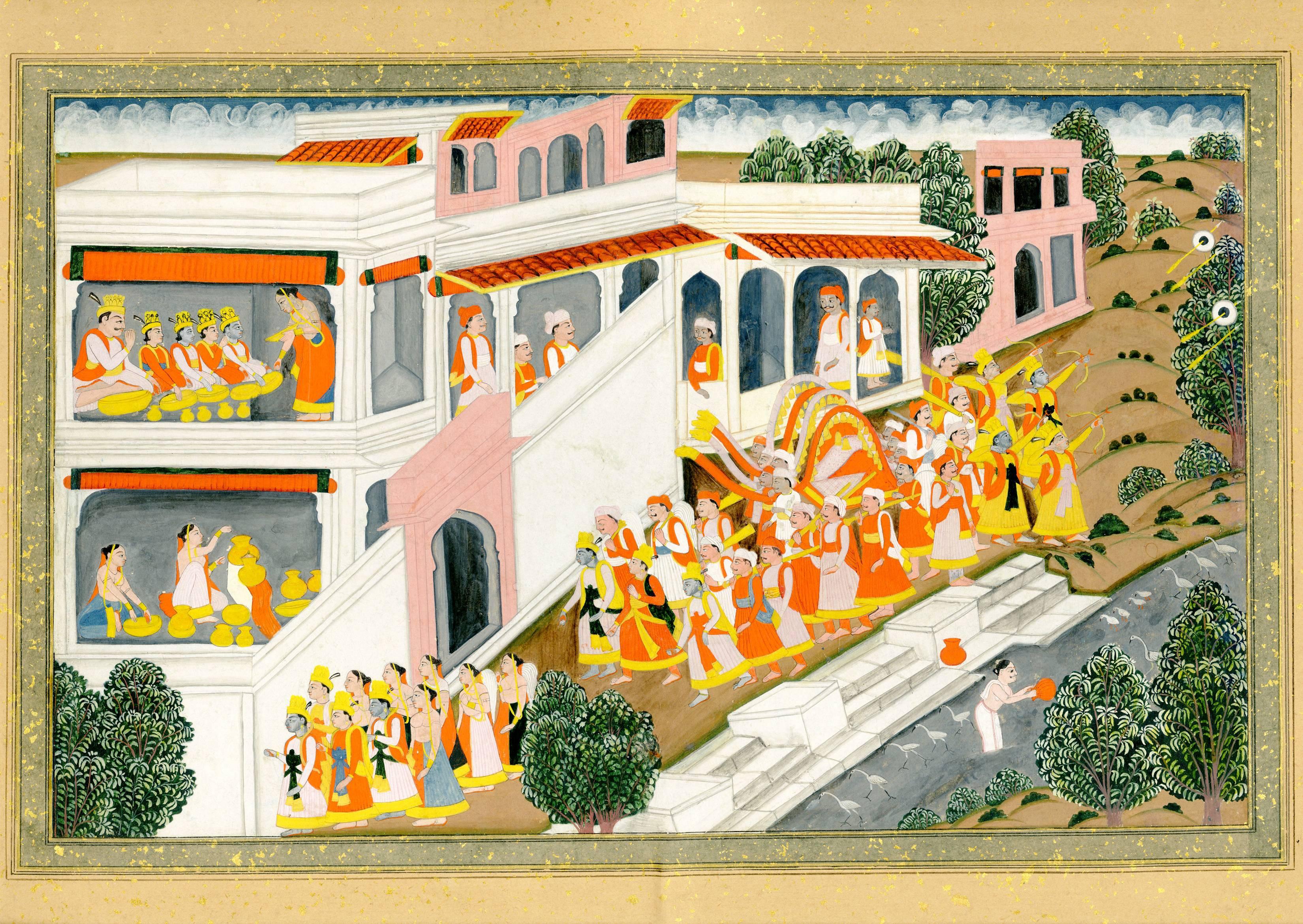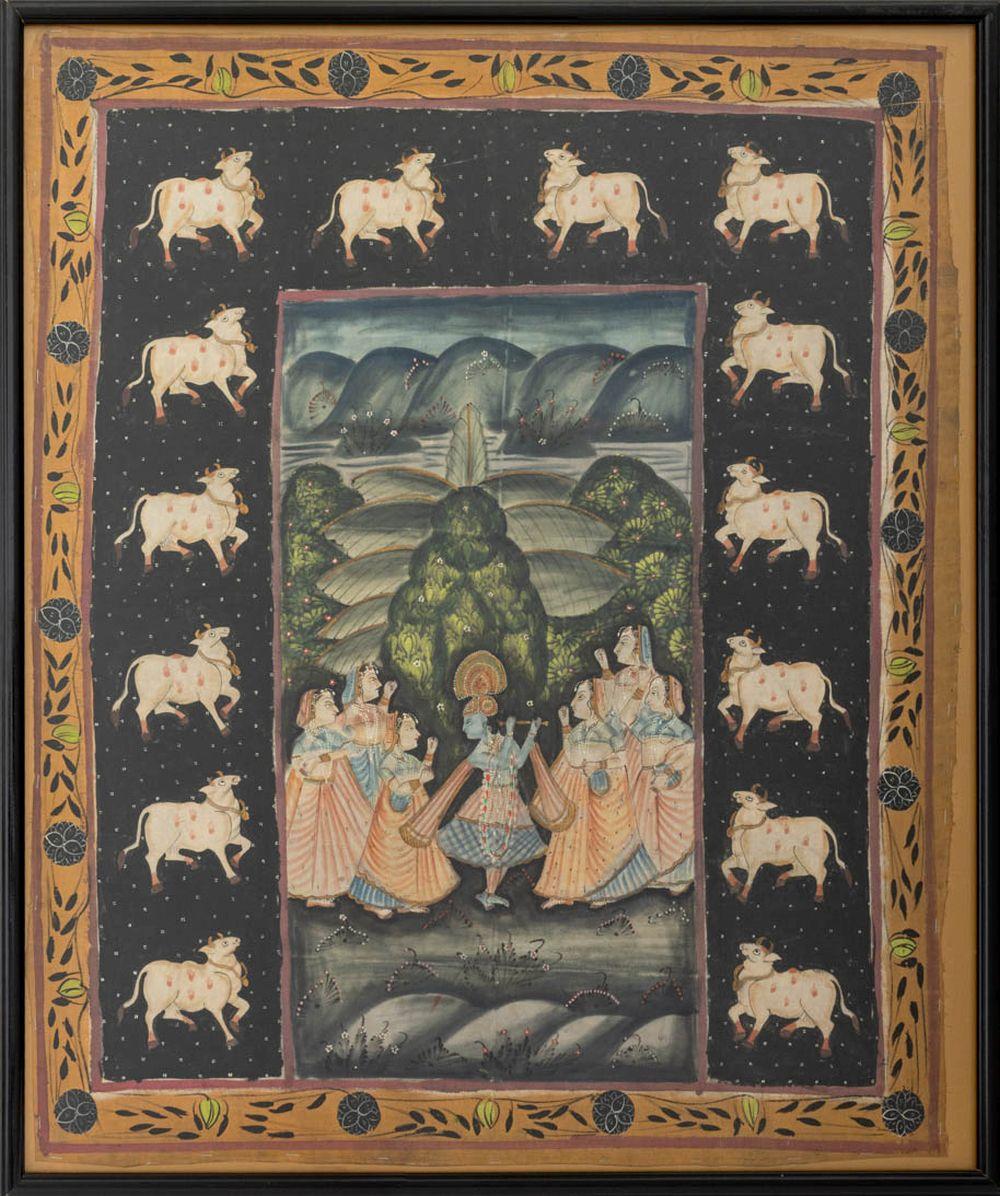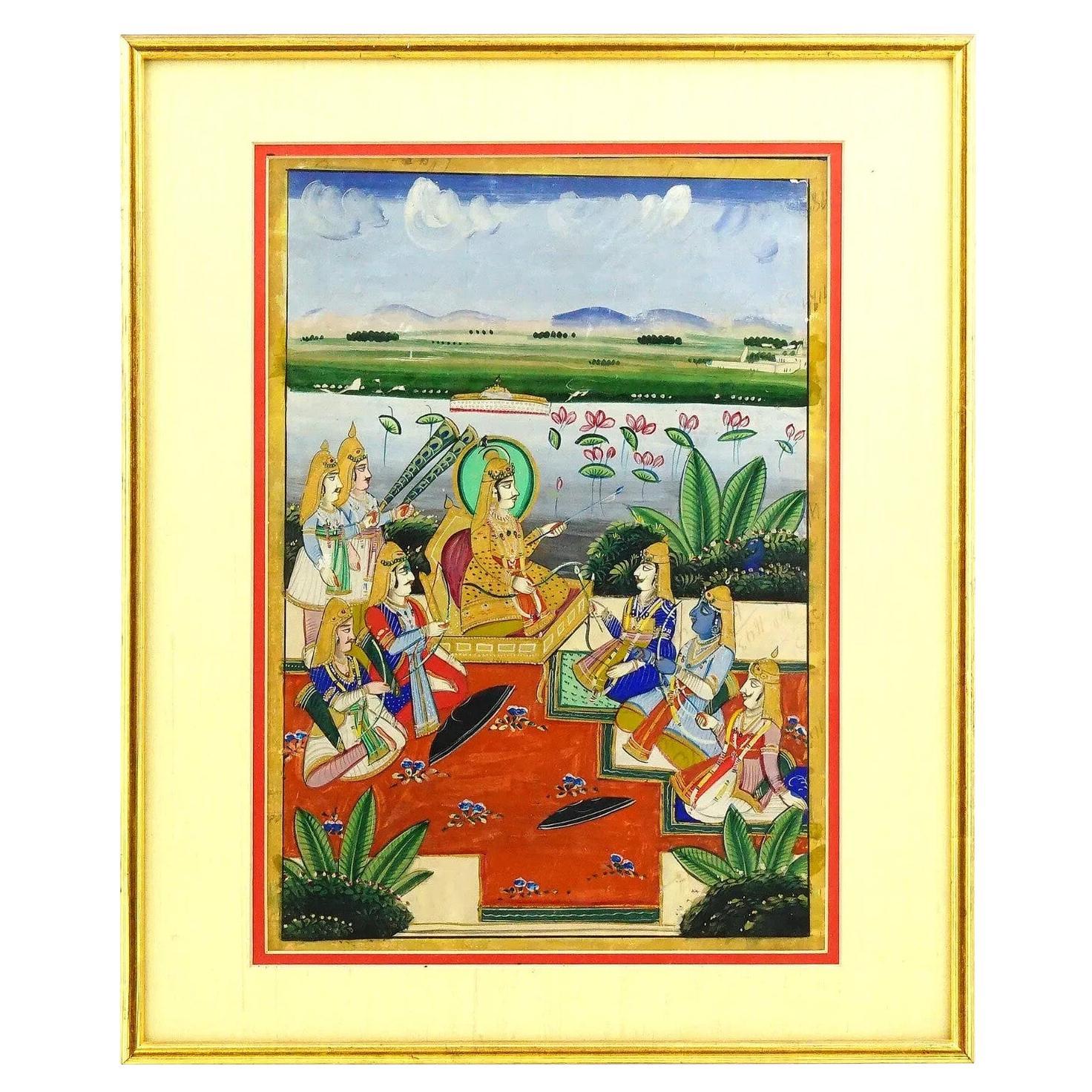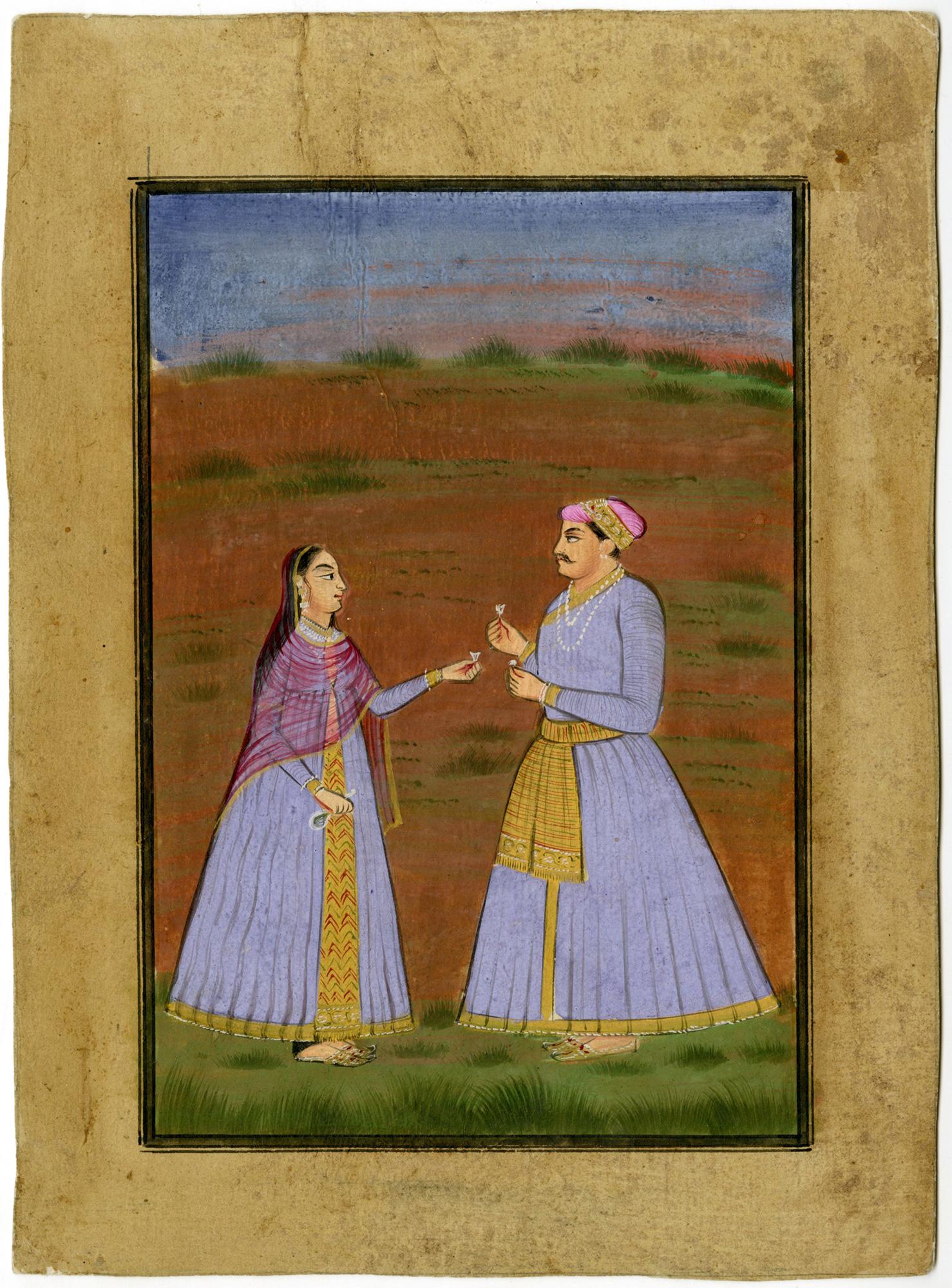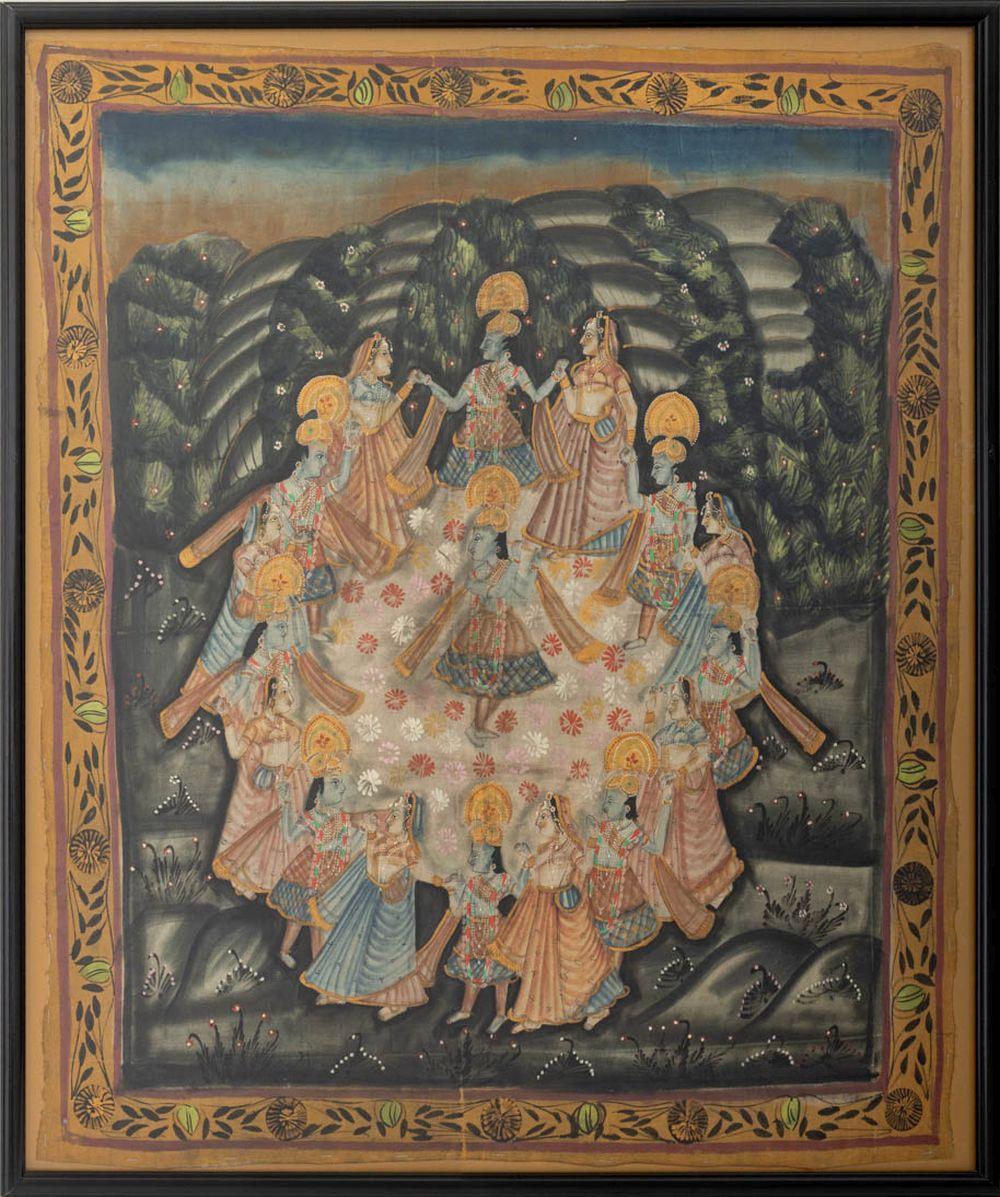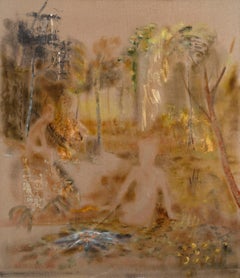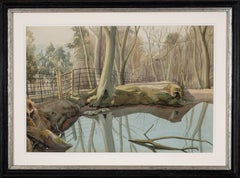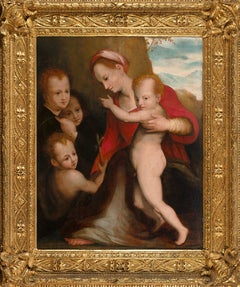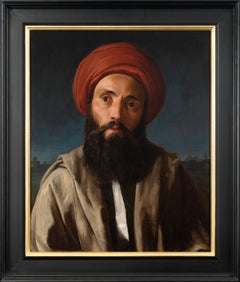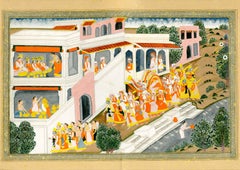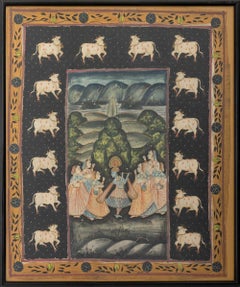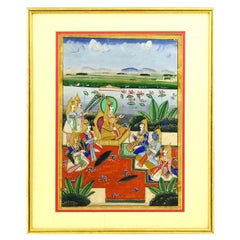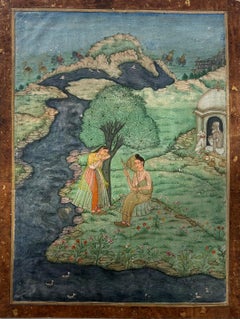Items Similar to An illustration to the musical mode of Patamanjari Ragini
Want more images or videos?
Request additional images or videos from the seller
1 of 10
UnknownAn illustration to the musical mode of Patamanjari Ragini1840
1840
$1,171.17
£850
€1,005.90
CA$1,613.59
A$1,797.76
CHF 938.52
MX$21,827.24
NOK 11,796.55
SEK 11,150.61
DKK 7,508.91
About the Item
Jaipur School, c. 1840
An illustration to the musical mode of Patamanjari Ragini
From a Ragamala series
Gouache and gold on wasli paper
24.1 x 19.6 cm.; (within frame) 33.7 x 28.5 cm.
Provenance:
Private Collection, United Kingdom.
This attractive illustration belongs to a dispersed Ragamala series, a sequence of visual representations of ragas, melodic frameworks belonging to Hindustani classical music. Designed to induce an emotional response in the listener, each raga possesses distinct structures and musical motifs which relate to colour, natural and biological cycles, and the seasons. The Patamanjari Ragini is a wistful melody sung by a woman separated from her beloved, a possible expression of the allegorical ‘love in separation’ of the human soul divided from God. The ragaini is commonly represented by a lady appeased by a confidante within a pavilion. Here the lady is in fine courtly dress and rests dolefully among cushions. Her female attendant sits opposite and holds a parrot on an outstretched forearm. Both are shaded under the embroidered canopy of a pavilion decorated with repeating floral spray motifs painted in fine gold. The pavilion is encircled by low walls with a vegetated garden beyond.
The Ragamala system developed as a specific genre of painting during the 15th century and dominated Indian miniature painting for some four centuries afterwards. The form is etymologically rooted in notions of colour and delight, and synthesises music, poetry and visual arts to evoke the rich joys and trials of love. Ragamala typically comprise of thirty-six or forty-two folio sheets, organised as personified familial figures which surround six central male ragas. Each of the six central ragas represent individual musical modes that correspond with the six seasons of summer, monsoon, autumn, early winter, winter, and spring. These male ragas possess children (ragaputras and ragaputris) and a harem of five wives (ragini), the secondary musical modes, as here with the consort Patamanjari Ragini. After the 16th century ragamala expanded from a divine to an anthropological focus, developing a human interest exemplified by the the ornate courtly costume and surroundings of the present work.
The present illustration is a good example of the Jaipur School, historically part of the Dhundhar region. Jaipur inherited the artistic legacy of Amber, and profited from a migration of artistic talent when in 1728 the city was made the new capital of Rajasthan. Miniature painting in Jaipur began under the patronage of the city’s founder, Sawai Jai Singh, and miniature paintings were often commissioned by members of royalty. The fine line quality of the present work is characteristic of this standard (achieved using fine squirrel hair brushes), as is the delicate gold painting which likely consists of gold dust combined with gum arabic and honey.
The work is mounted to an album page within a decorative border of consecutively painted margins, with a Devanagari inscription above describing the raga depicted. The work was acquired in India by the aristocratic grandfather of the recent private owner, from whom the work was acquired.
I am grateful to Martin Snowdon for his assistance in cataloguing this work.
Bibliography and further reading:
Giles Tillotson and Mrinalini Venkateswaran, eds., Painting and Photography at the Jaipur Court (New Delhi: Niyogi Books, 2016)
- Creation Year:1840
- Dimensions:Height: 13.27 in (33.7 cm)Width: 11.23 in (28.5 cm)
- Medium:
- Period:
- Condition:The work is in fair and stable condition. Historic staining to the upper centre discolours the inscription and sky, with some further markings to the lower left and right. The coloured mount is slightly abraded with some losses to the outer edge.
- Gallery Location:Maidenhead, GB
- Reference Number:Seller: Jaipur School1stDibs: LU2820215584552
About the Seller
No Reviews Yet
Vetted Professional Seller
Every seller passes strict standards for authenticity and reliability
Established in 2024
1stDibs seller since 2024
- ShippingRetrieving quote...Shipping from: Maidenhead, United Kingdom
- Return Policy
Authenticity Guarantee
In the unlikely event there’s an issue with an item’s authenticity, contact us within 1 year for a full refund. DetailsMoney-Back Guarantee
If your item is not as described, is damaged in transit, or does not arrive, contact us within 7 days for a full refund. Details24-Hour Cancellation
You have a 24-hour grace period in which to reconsider your purchase, with no questions asked.Vetted Professional Sellers
Our world-class sellers must adhere to strict standards for service and quality, maintaining the integrity of our listings.Price-Match Guarantee
If you find that a seller listed the same item for a lower price elsewhere, we’ll match it.Trusted Global Delivery
Our best-in-class carrier network provides specialized shipping options worldwide, including custom delivery.More From This Seller
View AllCinder
Located in Maidenhead, GB
Joel Tomlin (b. 1969)
Cinder, 2004
Oil on linen
Signed and titled verso
183 x 157 cm.
Provenance:
Joel Tomlin;
MW Projects, London, 2004;
Permanent Collection, Saatchi Gallery;
Chri...
Category
Early 2000s Contemporary Landscape Paintings
Materials
Oil
$7,164 Sale Price
20% Off
Woodland scene with a body of water
By John Nash
Located in Maidenhead, GB
British, 1954, Manner of John Nash (1893-1977)
Woodland scene with a body of water
Watercolour and graphite on paper, mounted to card
Signed indistinctly and dated lower left
34.1 x...
Category
1950s Post-War Landscape Drawings and Watercolors
Materials
Watercolor
The Virgin and Child with the Infant Baptist
By Andrea Del Sarto
Located in Maidenhead, GB
Florentine, mid-16th century
Circle of Tomaso D’Antonio Manzuoli, known as Maso da San Friano (1536-1571)
The Virgin and Child with the Infant Baptist
After Andrea del Sarto (1486-1...
Category
15th Century and Earlier Renaissance Figurative Paintings
Materials
Oil
Portrait of an Arab, with pyramids beyond
Located in Maidenhead, GB
Central European School, second half 19th century
Portrait of an Arab, with pyramids beyond
Oil on canvas
66.3 x 55.2 cm.; (within frame) 86.9 x 69.9 cm.
Unsigned
Provenance:
Privat...
Category
Mid-19th Century Portrait Paintings
Materials
Oil
Study for Mr and Mrs R. H. Butler and Their Daughters
By Bernard Fleetwood Walker
Located in Maidenhead, GB
Bernard Fleetwood-Walker RA RWS (1893-1965)
Study for Mr and Mrs R. H. Butler and Their Daughters, c. 1932
Graphite on paper, mounted to card
55.5 x 77.7 cm.; (within frame) 80.1 x 99.8 cm.
Provenance:
The artist’s studio, 1965 (no. 524);
Private Collection, United Kingdom.
Dated to c. 1932, the present drawing belongs to a series of five known preparatory studies for Mr and Mrs R. H. Butler and Their Daughters (1932), a large family composition...
Category
1930s Post-War Portrait Drawings and Watercolors
Materials
Watercolor
Study for Mr and Mrs R. H. Butler and Their Daughters
By Bernard Fleetwood Walker
Located in Maidenhead, GB
Bernard Fleetwood-Walker RA RWS (1893-1965)
Study for Mr and Mrs R. H. Butler and Their Daughters, c. 1932
Graphite, coloured graphite and wash on paper, mounted to card
64.5 x 74.5 cm.; (within frame) 87.4 x 91.8 cm.
Provenance:
The artist’s studio, 1965 (no. 525);
Private Collection, United Kingdom.
Dated to c. 1932, the present drawing belongs to a series of preparatory studies for Mr and Mrs R. H. Butler and Their Daughters (1932), a large family composition...
Category
1930s Post-War Portrait Drawings and Watercolors
Materials
Watercolor
You May Also Like
Palace with Vignettes of Scenes of Royal Court Life
Located in Fairlawn, OH
Palace with Vignettes of Scenes of Royal Court Life
Early 19th century Rajput School
Gouache on heavy paper, mounted to gold flecked support board
c. 1820
Unsigned as usual
Inscribed...
Category
1820s Rajput Landscape Paintings
Materials
Gouache
Indian Pichwai Painting, 19th C.
Located in Astoria, NY
Indian School, Pichwai Painting, 19th century, gouache on cloth, depicting the Hindu god Krishna, sacred cows, consorts, and attendants within a scrolling foliate border, black frame...
Category
19th Century Figurative Paintings
Materials
Textile, Gouache
Antique Indian Mughal Mixed Media Miniature Painting
Located in Long Island City, NY
An antique Indian Mughal Art mixed media, gouache and gold leaf, miniature painting. The artwork depicts a courtyard campaign scene with Maharaja, Deity, and warriors. Framed. Collec...
Category
Antique 19th Century Unknown Paintings
Materials
Paint
Indian Miniature Deccan School c1780 Ragamala Nature Figures River Trees
Located in Norfolk, GB
Indian Miniature
Category
Late 18th Century Other Art Style Figurative Paintings
Materials
Paper, Watercolor
Mughal School, 18th Century Emperor Jahangir with Empress Nur Jahan
Located in Middletown, NY
Emperor Jahangir and Empress Nur Jahan exchanging lotus blossoms; a symbol of beauty, purity, honesty, rebirth, self-regeneration, and enlightenment....
Category
18th Century Rajput Figurative Drawings and Watercolors
Materials
Gold
Indian Pichwai Painting, 19th C.
Located in Astoria, NY
Indian School, Pichwai Painting, 19th century, gouache on cloth, depicting the Hindu god Krishna, consorts, and attendants within a scrolling foliate border, black frame. Image: 43" ...
Category
19th Century Figurative Paintings
Materials
Textile, Gouache
More Ways To Browse
Musical Figures
Antique Miniature Painting
Hair Brush
Indian Gouache
Gold Frame 16th Century
Antique Squirrel
Squirrel Painting
Line Drawings Male
Harem Painting
Antique Rajasthan
Antique Hair Brush
Gold Squirrel
Antique Anthropology
Watercolor Floral Dress
Indian God Painting
Rajasthan Photography
Antique Indian Miniature Painting
Antique Indian Miniature Paintings
